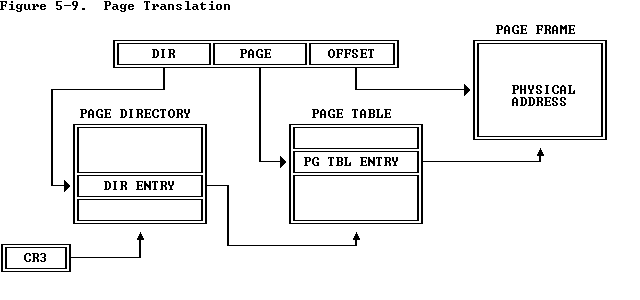
Two levels of tables are used to address a page of memory. At the higher
level is a page directory. The page directory addresses up to 1K page tables
of the second level. A page table of the second level addresses up to 1K
pages. All the tables addressed by one page directory, therefore, can
address 1M pages (2^(20)). Because each page contains 4K bytes 2^(12)
bytes), the tables of one page directory can span the entire physical
address space of the 80386 (2^(20) times 2^(12) = 2^(32)).
The physical address of the current page directory is stored in the CPU
register CR3, also called the page directory base register (PDBR). Memory
management software has the option of using one page directory for all
tasks, one page directory for each task, or some combination of the two.
Refer to
Chapter 10
for information on initialization of CR3 . Refer to
Chapter 7
to see how CR3 can change for each task .

5.2.3 Page Tables
A page table is simply an array of 32-bit page specifiers. A page table is
itself a page, and therefore contains 4 Kilobytes of memory or at most 1K
32-bit entries.
5.2.4 Page-Table Entries
Entries in either level of page tables have the same format.
Figure 5-10
illustrates this format.
5.2.4.1 Page Frame Address
The page frame address specifies the physical starting address of a page. Because pages are located on 4K boundaries, the low-order 12 bits are always zero. In a page directory, the page frame address is the address of a page table. In a second-level page table, the page frame address is the address of the page frame that contains the desired memory operand.5.2.4.2 Present Bit
The Present bit indicates whether a page table entry can be used in address translation. P=1 indicates that the entry can be used.When P=0 in either level of page tables, the entry is not valid for address translation, and the rest of the entry is available for software use; none of the other bits in the entry is tested by the hardware. Figure 5-11 illustrates the format of a page-table entry when P=0.
If P=0 in either level of page tables when an attempt is made to use a page-table entry for address translation, the processor signals a page exception. In software systems that support paged virtual memory, the page-not-present exception handler can bring the required page into physical memory. The instruction that caused the exception can then be reexecuted. Refer to Chapter 9 for more information on exception handlers .
Note that there is no present bit for the page directory itself. The page directory may be not-present while the associated task is suspended, but the operating system must ensure that the page directory indicated by the CR3 image in the TSS is present in physical memory before the task is dispatched . Refer to Chapter 7 for an explanation of the TSS and task dispatching.
The processor sets the corresponding accessed bits in both levels of page
tables to one before a read or write operation to a page.
The processor sets the dirty bit in the second-level page table to one
before a write to an address covered by that page table entry. The dirty bit
in directory entries is undefined.
An operating system that supports paged virtual memory can use these bits
to determine what pages to eliminate from physical memory when the demand
for memory exceeds the physical memory available. The operating system is
responsible for testing and clearing these bits.
Refer to
Chapter 11
for how the 80386 coordinates updates to the accessed
and dirty bits in multiprocessor systems.
The existence of the page-translation cache is invisible to applications
programmers but not to systems programmers; operating-system programmers
must flush the cache whenever the page tables are changed. The
page-translation cache can be flushed by either of two methods:
up:
Chapter 5 -- Memory Management

5.2.4.3 Accessed and Dirty Bits
These bits provide data about page usage in both levels of the page tables.
With the exception of the dirty bit in a page directory entry, these bits
are set by the hardware; however, the processor does not clear any of these
bits.
5.2.4.4 Read/Write and User/Supervisor Bits
These bits are not used for address translation, but are used for
page-level protection, which the processor performs at the same time as
address translation . Refer to
Chapter 6
where protection is discussed in
detail.
5.2.5 Page Translation Cache
For greatest efficiency in address translation, the processor stores the
most recently used page-table data in an on-chip cache. Only if the
necessary paging information is not in the cache must both levels of page
tables be referenced.
MOV CR3, EAX
prev: 5.1 Segment Translation
next: 5.3 Combining Segment and Page Translation